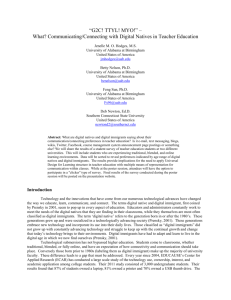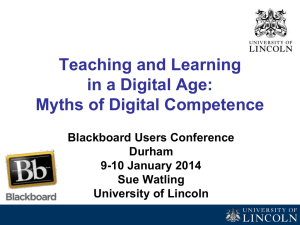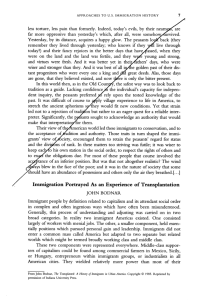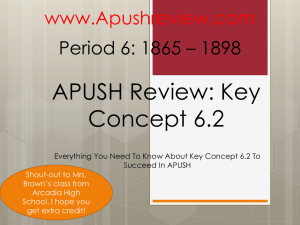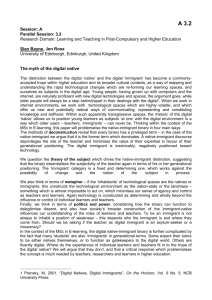Digital Natives, Digital Immigrants
advertisement
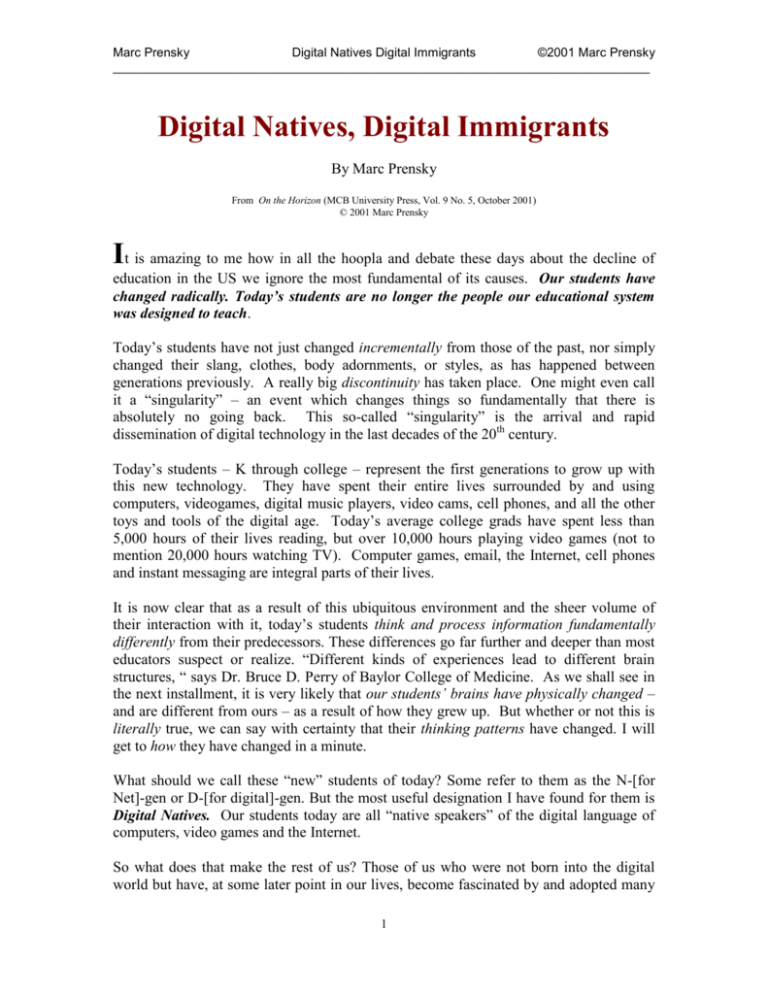
Marc Prensky Digital Natives Digital Immigrants ©2001 Marc Prensky _____________________________________________________________________________ Digital Natives, Digital Immigrants By Marc Prensky From On the Horizon (MCB University Press, Vol. 9 No. 5, October 2001) © 2001 Marc Prensky It is amazing to me how in all the hoopla and debate these days about the decline of education in the US we ignore the most fundamental of its causes. Our students have changed radically. Today’s students are no longer the people our educational system was designed to teach. Today‟s students have not just changed incrementally from those of the past, nor simply changed their slang, clothes, body adornments, or styles, as has happened between generations previously. A really big discontinuity has taken place. One might even call it a “singularity” – an event which changes things so fundamentally that there is absolutely no going back. This so-called “singularity” is the arrival and rapid dissemination of digital technology in the last decades of the 20th century. Today‟s students – K through college – represent the first generations to grow up with this new technology. They have spent their entire lives surrounded by and using computers, videogames, digital music players, video cams, cell phones, and all the other toys and tools of the digital age. Today‟s average college grads have spent less than 5,000 hours of their lives reading, but over 10,000 hours playing video games (not to mention 20,000 hours watching TV). Computer games, email, the Internet, cell phones and instant messaging are integral parts of their lives. It is now clear that as a result of this ubiquitous environment and the sheer volume of their interaction with it, today‟s students think and process information fundamentally differently from their predecessors. These differences go far further and deeper than most educators suspect or realize. “Different kinds of experiences lead to different brain structures, “ says Dr. Bruce D. Perry of Baylor College of Medicine. As we shall see in the next installment, it is very likely that our students’ brains have physically changed – and are different from ours – as a result of how they grew up. But whether or not this is literally true, we can say with certainty that their thinking patterns have changed. I will get to how they have changed in a minute. What should we call these “new” students of today? Some refer to them as the N-[for Net]-gen or D-[for digital]-gen. But the most useful designation I have found for them is Digital Natives. Our students today are all “native speakers” of the digital language of computers, video games and the Internet. So what does that make the rest of us? Those of us who were not born into the digital world but have, at some later point in our lives, become fascinated by and adopted many 1 Marc Prensky Digital Natives Digital Immigrants ©2001 Marc Prensky _____________________________________________________________________________ or most aspects of the new technology are, and always will be compared to them, Digital Immigrants. The importance of the distinction is this: As Digital Immigrants learn – like all immigrants, some better than others – to adapt to their environment, they always retain, to some degree, their "accent," that is, their foot in the past. The “digital immigrant accent” can be seen in such things as turning to the Internet for information second rather than first, or in reading the manual for a program rather than assuming that the program itself will teach us to use it. Today‟s older folk were "socialized" differently from their kids, and are now in the process of learning a new language. And a language learned later in life, scientists tell us, goes into a different part of the brain. There are hundreds of examples of the digital immigrant accent. They include printing out your email (or having your secretary print it out for you – an even “thicker” accent); needing to print out a document written on the computer in order to edit it (rather than just editing on the screen); and bringing people physically into your office to see an interesting web site (rather than just sending them the URL). I‟m sure you can think of one or two examples of your own without much effort. My own favorite example is the “Did you get my email?” phone call. Those of us who are Digital Immigrants can, and should, laugh at ourselves and our “accent.” But this is not just a joke. It‟s very serious, because the single biggest problem facing education today is that our Digital Immigrant instructors, who speak an outdated language (that of the pre-digital age), are struggling to teach a population that speaks an entirely new language. This is obvious to the Digital Natives – school often feels pretty much as if we‟ve brought in a population of heavily accented, unintelligible foreigners to lecture them. They often can‟t understand what the Immigrants are saying. What does “dial” a number mean, anyway? Lest this perspective appear radical, rather than just descriptive, let me highlight some of the issues. Digital Natives are used to receiving information really fast. They like to parallel process and multi-task. They prefer their graphics before their text rather than the opposite. They prefer random access (like hypertext). They function best when networked. They thrive on instant gratification and frequent rewards. They prefer games to “serious” work. (Does any of this sound familiar?) But Digital Immigrants typically have very little appreciation for these new skills that the Natives have acquired and perfected through years of interaction and practice. These skills are almost totally foreign to the Immigrants, who themselves learned – and so choose to teach – slowly, step-by-step, one thing at a time, individually, and above all, seriously. “My students just don‟t _____ like they used to,” Digital Immigrant educators grouse. I can‟t get them to ____ or to ____. They have no appreciation for _____ or _____ . (Fill in the blanks, there are a wide variety of choices.) 2 Marc Prensky Digital Natives Digital Immigrants ©2001 Marc Prensky _____________________________________________________________________________ Digital Immigrants don‟t believe their students can learn successfully while watching TV or listening to music, because they (the Immigrants) can‟t. Of course not – they didn‟t practice this skill constantly for all of their formative years. Digital Immigrants think learning can‟t (or shouldn‟t) be fun. Why should they – they didn‟t spend their formative years learning with Sesame Street. Unfortunately for our Digital Immigrant teachers, the people sitting in their classes grew up on the “twitch speed” of video games and MTV. They are used to the instantaneity of hypertext, downloaded music, phones in their pockets, a library on their laptops, beamed messages and instant messaging. They‟ve been networked most or all of their lives. They have little patience for lectures, step-by-step logic, and “tell-test” instruction. Digital Immigrant teachers assume that learners are the same as they have always been, and that the same methods that worked for the teachers when they were students will work for their students now. But that assumption is no longer valid. Today‟s learners are different. “Www.hungry.com” said a kindergarten student recently at lunchtime. “Every time I go to school I have to power down,” complains a high-school student. Is it that Digital Natives can’t pay attention, or that they choose not to? Often from the Natives‟ point of view their Digital Immigrant instructors make their education not worth paying attention to compared to everything else they experience – and then they blame them for not paying attention! And, more and more, they won‟t take it. “I went to a highly ranked college where all the professors came from MIT,” says a former student. “But all they did was read from their textbooks. I quit.” In the giddy internet bubble of a only a short while ago – when jobs were plentiful, especially in the areas where school offered little help – this was a real possibility. But the dot-com dropouts are now returning to school. They will have to confront once again the Immigrant/Native divide, and have even more trouble given their recent experiences. And that will make it even harder to teach them – and all the Digital Natives already in the system – in the traditional fashion. So what should happen? Should the Digital Native students learn the old ways, or should their Digital Immigrant educators learn the new? Unfortunately, no matter how much the Immigrants may wish it, it is highly unlikely the Digital Natives will go backwards. In the first place, it may be impossible – their brains may already be different. It also flies in the face of everything we know about cultural migration. Kids born into any new culture learn the new language easily, and forcefully resist using the old. Smart adult immigrants accept that they don‟t know about their new world and take advantage of their kids to help them learn and integrate. Not-so-smart (or not-so-flexible) immigrants spend most of their time grousing about how good things were in the “old country.” So unless we want to just forget about educating Digital Natives until they grow up and do it themselves, we had better confront this issue. And in so doing we need to reconsider both our methodology and our content. 3 Marc Prensky Digital Natives Digital Immigrants ©2001 Marc Prensky _____________________________________________________________________________ First, our methodology. Today‟s teachers have to learn to communicate in the language and style of their students. This doesn’t mean changing the meaning of what is important, or of good thinking skills. But it does mean going faster, less step-by step, more in parallel, with more random access, among other things. Educators might ask “But how do we teach logic in this fashion?” While it‟s not immediately clear, we do need to figure it out. Second, our content. It seems to me that after the digital “singularity” there are now two kinds of content: “Legacy” content (to borrow the computer term for old systems) and “Future” content. “Legacy” content includes reading, writing, arithmetic, logical thinking, understanding the writings and ideas of the past, etc – all of our “traditional” curriculum. It is of course still important, but it is from a different era. Some of it (such as logical thinking) will continue to be important, but some (perhaps like Euclidean geometry) will become less so, as did Latin and Greek. “Future” content is to a large extent, not surprisingly, digital and technological. But while it includes software, hardware, robotics, nanotechnology, genomics, etc. it also includes the ethics, politics, sociology, languages and other things that go with them. This “Future” content is extremely interesting to today‟s students. But how many Digital Immigrants are prepared to teach it? Someone once suggested to me that kids should only be allowed to use computers in school that they have built themselves. It‟s a brilliant idea that is very doable from the point of view of the students‟ capabilities. But who could teach it? As educators, we need to be thinking about how to teach both Legacy and Future content in the language of the Digital Natives. The first involves a major translation and change of methodology; the second involves all that PLUS new content and thinking. It‟s not actually clear to me which is harder – “learning new stuff” or “learning new ways to do old stuff.” I suspect it‟s the latter. So we have to invent, but not necessarily from scratch. Adapting materials to the language of Digital Natives has already been done successfully. My own preference for teaching Digital Natives is to invent computer games to do the job, even for the most serious content. After all, it‟s an idiom with which most of them are totally familiar. Not long ago a group of professors showed up at my company with new computer-aided design (CAD) software they had developed for mechanical engineers. Their creation was so much better than what people were currently using that they had assumed the entire engineering world would quickly adopt it. But instead they encountered a lot of resistance, due in large part to the product‟s extremely steep learning curve – the software contained hundreds of new buttons, options and approaches to master. 4 Marc Prensky Digital Natives Digital Immigrants ©2001 Marc Prensky _____________________________________________________________________________ Their marketers, however, had a brilliant idea. Observing that the users of CAD software were almost exclusively male engineers between 20 and 30, they said “Why not make the learning into a video game!” So we invented and created for them a computer game in the “first person shooter” style of the consumer games Doom and Quake, called The Monkey Wrench Conspiracy. Its player becomes an intergalactic secret agent who has to save a space station from an attack by the evil Dr. Monkey Wrench. The only way to defeat him is to use the CAD software, which the learner must employ to build tools, fix weapons, and defeat booby traps. There is one hour of game time, plus 30 “tasks,” which can take from 15 minutes to several hours depending on one‟s experience level. Monkey Wrench has been phenomenally successful in getting young people interested in learning the software. It is widely used by engineering students around the world, with over 1 million copies of the game in print in several languages. But while the game was easy for my Digital Native staff to invent, creating the content turned out to be more difficult for the professors, who were used to teaching courses that started with “Lesson 1 – the Interface.” We asked them instead to create a series of graded tasks into which the skills to be learned were embedded. The professors had made 5-10 minute movies to illustrate key concepts; we asked them to cut them to under 30 seconds. The professors insisted that the learners to do all the tasks in order; we asked them to allow random access. They wanted a slow academic pace, we wanted speed and urgency (we hired a Hollywood script writer to provide this.) They wanted written instructions; we wanted computer movies. They wanted the traditional pedagogical language of “learning objectives,” “mastery”, etc. (e.g. “in this exercise you will learn…”); our goal was to completely eliminate any language that even smacked of education. In the end the professors and their staff came through brilliantly, but because of the large mind-shift required it took them twice as long as we had expected. As they saw the approach working, though, the new “Digital Native” methodology became their model for more and more teaching – both in and out of games – and their development speed increased dramatically. Similar rethinking needs to be applied to all subjects at all levels. Although most attempts at “edutainment” to date have essentially failed from both the education and entertainment perspective, we can – and will, I predict – do much better. In math, for example, the debate must no longer be about whether to use calculators and computers – they are a part of the Digital Natives‟ world – but rather how to use them to instill the things that are useful to have internalized, from key skills and concepts to the multiplication tables. We should be focusing on “future math” – approximation, statistics, binary thinking. In geography – which is all but ignored these days – there is no reason that a generation that can memorize over 100 Pokémon characters with all their characteristics, history and evolution can‟t learn the names, populations, capitals and relationships of all the 101 nations in the world. It just depends on how it is presented. 5 Marc Prensky Digital Natives Digital Immigrants ©2001 Marc Prensky _____________________________________________________________________________ We need to invent Digital Native methodologies for all subjects, at all levels, using our students to guide us. The process has already begun – I know college professors inventing games for teaching subjects ranging from math to engineering to the Spanish Inquisition. We need to find ways of publicizing and spreading their successes. A frequent objection I hear from Digital Immigrant educators is “this approach is great for facts, but it wouldn‟t work for „my subject.‟” Nonsense. This is just rationalization and lack of imagination. In my talks I now include “thought experiments” where I invite professors and teachers to suggest a subject or topic, and I attempt– on the spot – to invent a game or other Digital Native method for learning it. Classical philosophy? Create a game in which the philosophers debate and the learners have to pick out what each would say. The Holocaust? Create a simulation where students role-play the meeting at Wannsee, or one where they can experience the true horror of the camps, as opposed to the films like Schindler’s List. It‟s just dumb (and lazy) of educators – not to mention ineffective – to presume that (despite their traditions) the Digital Immigrant way is the only way to teach, and that the Digital Natives‟ “language” is not as capable as their own of encompassing any and every idea. So if Digital Immigrant educators really want to reach Digital Natives – i.e. all their students – they will have to change. It‟s high time for them to stop their grousing, and as the Nike motto of the Digital Native generation says, “Just do it!” They will succeed in the long run – and their successes will come that much sooner if their administrators support them. See also: Digital Natives, Digital Immigrants Part 2: The scientific evidence behind the Digital Native’s thinking changes, and the evidence that Digital Native-style learning works! Marc Prensky is an internationally acclaimed thought leader, speaker, writer, consultant, and game designer in the critical areas of education and learning. He is the author of Digital Game-Based Learning (McGraw-Hill, 2001), founder and CEO of Games2train, a game-based learning company, and founder of The Digital Multiplier, an organization dedicated to eliminating the digital divide in learning worldwide. He is also the creator of the sites <www.SocialImpactGames.com>, <www.DoDGameCommunity.com> and <www.GamesParentsTeachers.com> . Marc holds an MBA from Harvard and a Masters in Teaching from Yale. More of his writings can be found at <www.marcprensky.com/writing/default.asp>. Contact Marc at marc@games2train.com. . 6
